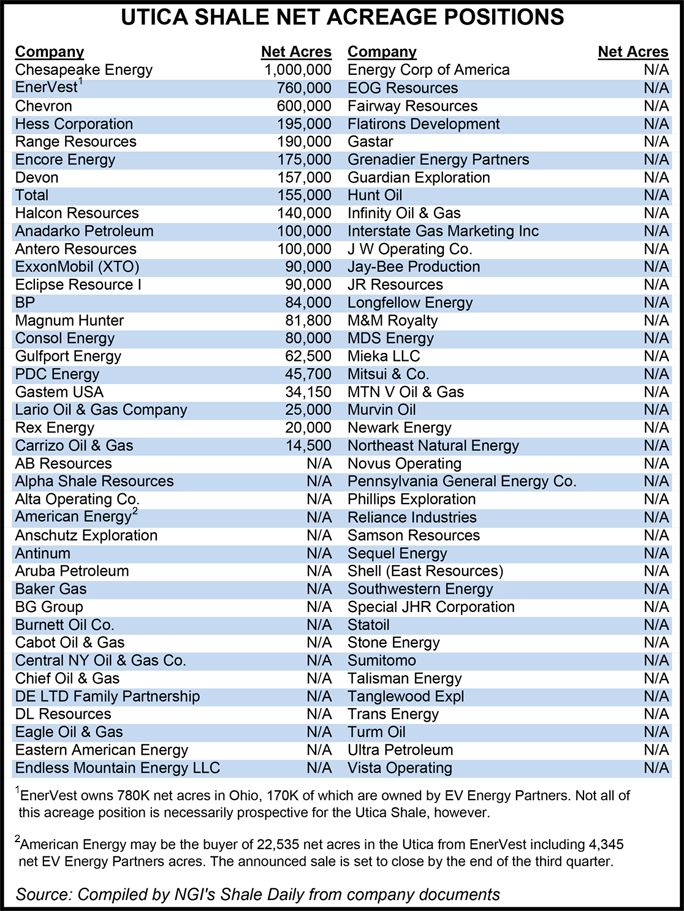Utica Shale | NGI All News Access
McClendon’s E&P Readying Comeback in U.S. Onshore
Aubrey McClendon hasn’t taken long to gallop back in the U.S. onshore unconventional drilling business, if analysts are to be believed.

The controversial risk-taker, who tended to bend the rules as co-founder of Chesapeake Energy Corp., was forced out this year but he appears to be making a comeback onto the exploration and production (E&P) stage, with one of his start-ups said to be the buyer of at least one, and possibly more, leaseholds in the Utica Shale, sources told NGI’s Shale Daily.
McClendon, 54, made no secret of his plans to venture back into the onshore after he was ousted from Chesapeake. He began publicly setting up shop in mid-April at an office complex he owned a short distance from his former headquarters in Oklahoma City (seeShale Daily, April 17). Oklahoma records indicated at the time that McClendon had registered American Energy Partners LP, Arcadia Capital LLC and McClendon Energy Operating LLC.
The oil and natural gas enthusiast again is pursuing land to develop and may in fact already own a doozy.
American Energy has been cited by several sources as the buyer of some Utica Shale property from EV Energy Partners LP’s (EVEP) earlier this month (see Shale Daily, Aug. 13). The $284 million sale by exploration arm EnerVest Ltd. was with an “undisclosed” and privately owned E&P involving 22,535 net acres.
EVEP officials also said this month they were working with an unnamed company to develop more than 4,000 net acres in three of Ohio’s most heavily drilled counties: Guernsey, Harrison and Noble. EVEP (760,000 net acres) is second only to Chesapeake (1 million net acres) in acreage holdings in the Ohio play. EVEP also partners with Chesapeake and Total SA on some of the leasehold.
EVEP’s executives estimated that they received about $12,900/acre on average in the transaction; it’s expected to close by the end of September. The undisclosed producer and EVEP also are in negotiations with the silent partner to form a joint venture to develop land in Ohio’s Tuscarawas and Stark counties.
There was no comment from American Energy about whether it was the buyer in EVEP’s recent sale. However, at the EnerCom Consulting’s oil and gas conference earlier this month in Denver, more than one analyst said many people were hearing that McClendon was the buyer.
Wells Fargo’s David Tameron and Gordon Douthat said reports from “very good sources” indicated that American Energy was “getting aggressive in the basin” and had purchased the EVEP divestment. American Energy also is said to have been the buyer of a recent Utica leasehold divestment by a unit of Royal Dutch Shell plc, said the analysts. With that package and EVEP’s, “American Energy is accumulating a nice acreage position in the Utica.”
Two other sources also confirmed that they’d heard similar reports about American Energy buying up leaseholds in the northeastern play. “That is what we heard,” one source who wished to remain anonymous told NGI’s Shale Daily.
When Chesapeake first began publicly discussing its Utica holdings two years ago, the former CEO said at an energy summit in Ohio that the Utica could be the “biggest thing economically to hit Ohio, since maybe the plow” (see Shale Daily, Sept. 22, 2011). McClendon said then the company had “arrived at two conclusions: One, it’s big. Two, a lot of the acreage on it was owned by EnerVest,” acknowledging EVEP Chairman John Walker who also attended the summit. “We’d always been friends, but I got chummier.”
“Now we’re best friends,” Walker replied.
On American Energy’s website, the company claims that there is an “unprecedented opportunity — for the right company, under the right leadership, at the right time…We’re ready to lead and our time is now.” The website said under McClendon’s leadership, the E&P “has a singular purpose: to capture some of the vast opportunities available today” in the U.S. oil and natural gas industry.
Sounding much like its founder, American Energy’s website states that it “represents a creative new approach for a rapidly changing industry. We’re built to be opportunistic and bold. We are a start-up, but we are ready to make our mark.”
After McClendon moved to his new headquarters in April, he began conducting informal meetings with potential financiers. He also sent a six-page query to several private equity firms seeking money. Portions of the letter were provided to NGI. The letter said McClendon planned to raise $2-3 billion of initial equity, and he indicated that his management team would keep a big cut of new profits for the E&P, about half of all earnings once the investment-return threshold was met. McClendon also said he wanted to maintain more control of the company.
The “discovery phase” of unconventional gas drilling was over, McClendon wrote. “The next phase of the industry’s development will be equally dynamic and potentially even more rewarding for investors. The time to move is now.” He is said to have captured more than $1 billion in private equity from the query.
Meanwhile, McClendon’s former running buddies at Chesapeake are looking for new jobs. Long-time COO Steve Dixon, who helped to build the vast U.S. portfolio, left to “pursue other opportunities” earlier this month, according to McClendon’s replacement, CEO Doug Lawler (see Shale Daily, Aug. 14). Leaving as well were Executive Vice President Jeff Fisher, who handled production, and senior vice presidents Steve Miller (drilling) and Martha Burger, who was chief of human and corporate resources. Chesapeake executives Henry Hood and Tom Price left in May to join McClendon in his new ventures.
© 2024 Natural Gas Intelligence. All rights reserved.
ISSN © 2577-9877 | ISSN © 2158-8023 |

